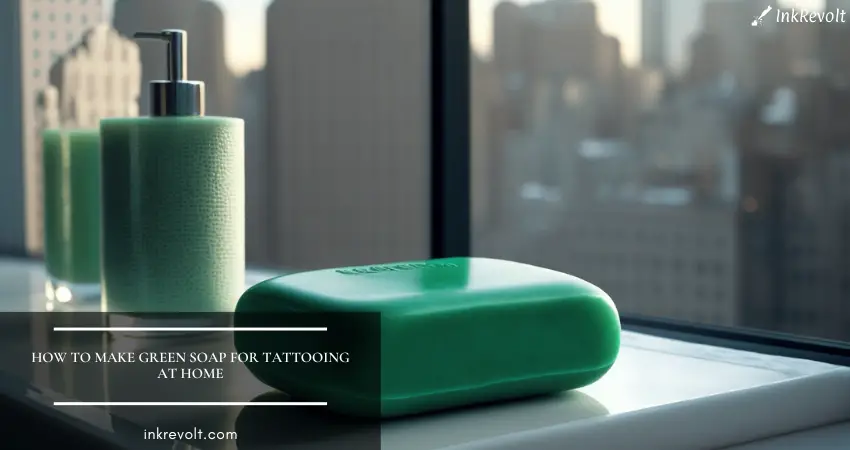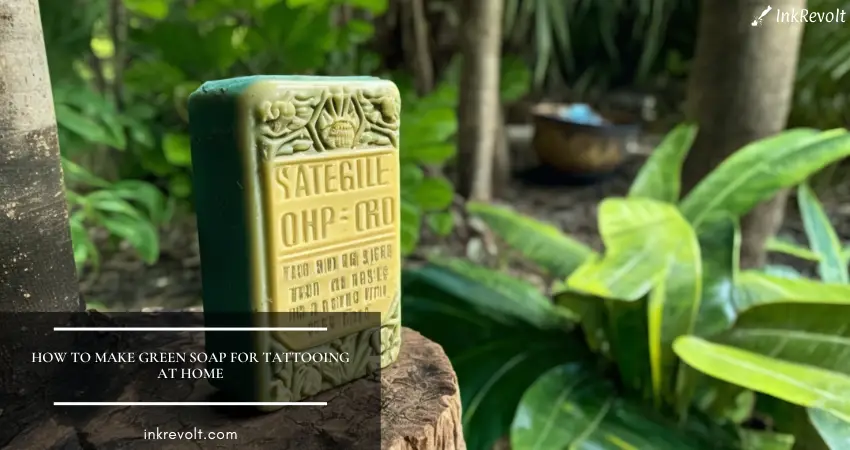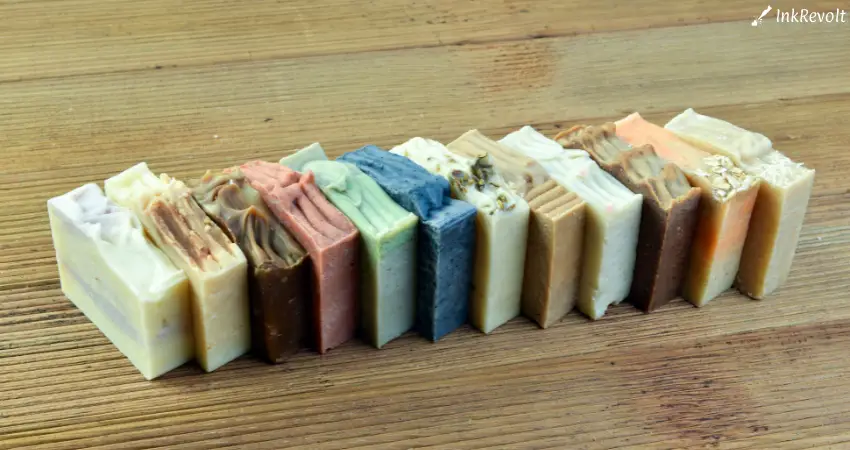How To Make Green Soap For Tattooing At Home
The necessity of hygiene in tattooing cannot be overstated. It’s required before, during, and after a tattoo procedure. Indeed, a tattoo artist will regularly clean the tattoo as they work to remove excess ink. Green soap is a highly effective all-purpose disinfectant.
It not only removes blood, filth, and germs, but it also moisturizes and relaxes the skin around the tattooed area. So, the question is, How to make green soap for tattooing at home?
To begin with, 1 cup of distilled water should be boiled and cooled. 2 teaspoons chlorhexidine gluconate, 2 tablespoons glycerin, 1/4 cup Castile soap, and 2-3 drops essential oil should be combined in a mixing dish. To thoroughly combine the ingredients, stir them together. While stirring, gradually add the cooled distilled water to the mixture. Fill a clean bottle halfway with soap and shake vigorously.
I have discussed every part of the answer to creating green soap for tattooing at home that you may be looking for. So stick around to learn more.

Why Green Soap Is Different from Regular Soap?
Green soap is a type of soap used in medical and cosmetic procedures, made from a combination of glycerin, vegetable oils, and vegetable alcohol.
It differs from regular soap in its ingredients and intended use. Green soap is gentler on the skin and is used as a pre-procedural skin cleaner, while regular soap may contain harsher ingredients and is meant for general hygiene. It is different from regular soap in several key ways.
Composition
Green soap is made from natural ingredients such as vegetable oils, glycerin, and water. It is free from harsh chemicals such as parabens and sulfates that are commonly found in regular soaps. This makes it gentler on the skin and more suitable for use on sensitive skin types.
Purpose
Regular soap is primarily used for personal hygiene and to cleanse the skin. Green soap, on the other hand, is specifically designed for use in medical and beauty treatments such as massage, tattooing, and electrolysis.
Antiseptic Properties
Green soap is known for its antiseptic properties, which make it useful for cleaning and sanitizing skin prior to medical procedures. Regular soap, while it may contain some antiseptic ingredients, is not specifically formulated for this purpose.
pH Balance
The pH balance of green soap is slightly alkaline, which helps to soothe and calm irritated skin. Regular soap, on the other hand, can have a more neutral or acidic pH balance which can cause dryness and irritation in some individuals.
Overall, green soap is a specialized type of soap that is designed for specific purposes, making it different from regular soap in terms of composition, purpose, antiseptic properties, and pH balance.

How to Make Green Soap for Tattooing at Home
Tattoo artists will always wash the skin with green soap or an equivalent substance before commencing a tattoo. Every skilled tattoo artist must have clean, sterilized skin as part of their preparation procedure. To make green soap for tattooing at home, you will need the following ingredients:
Things You’ll Need
- Distilled water
- Chlorhexidine gluconate
- Glycerin
- Castile soap
- Essential oil (e.g. tea tree, eucalyptus) times.
Steps to Follow
Step 1: Measure the oils
Pour equal parts of olive oil and coconut oil into a large mixing bowl.
Step 2: Prepare the lye solution
In a separate bowl, mix the sodium hydroxide with water and stir until it is completely dissolved.
Step 3: Mix the oils and lye solution
Slowly pour the lye solution into the oils and stir constantly.
Step 4: Stir until trace
Keep stirring the mixture until it reaches trace, which is when it starts to thicken and look like pudding.
Step 5: Add green dye
Once the mixture has reached trace, add a few drops of green dye and mix thoroughly.
Step 6: Pour into molds
Pour the mixture into molds, such as silicone molds or old soap molds, and allow it to sit for 24 hours.
Step 7: Cut into bars
Once the soap has set, remove it from the molds and cut it into bars.
Step 8: Cure
Leave the soap bars to cure for 4-6 weeks in a cool, dry place.
Step 9: Use
After the curing period, the green soap is ready to use for tattooing. Simply lather it up and apply to the skin before starting the tattoo process.
Green Soap Uses For Tattoos
Green soap is a popular solution used in the tattooing industry as a pre and post tattoo cleansing agent. It is known for its antiseptic and antimicrobial properties, which help to prevent the spread of infection during the tattooing process.
The soap is made from a combination of natural ingredients, including glycerin, olive oil, and soapberries, which provide gentle cleansing and moisturizing properties.
Before the tattooing process, green soap is used to clean the skin and remove any dirt, oil, or bacteria that may interfere with the tattoo ink. It helps to prepare the skin for the tattooing process and ensures that the area is free from any potential contaminants.
After the tattooing process, green soap is used to clean and care for the tattooed area. It helps to soothe any skin irritation and reduce redness. The soap also helps to prevent infection and promote healing, ensuring that the tattoo retains its color and crisp lines.
In summary, green soap plays a crucial role in maintaining the health and appearance of tattoos and is essential for both the pre and post tattoo care process.
Green Soap Side Effects
Green soap is a type of soap that is commonly used in healthcare settings for cleaning skin and removing dirt, debris, and contaminants. It is made from saponified vegetable oils and is considered safe for most people. However, some people may experience side effects when using green soap.
Some of the most common side effects of green soap include:
Skin irritation
If you have sensitive skin or you’re allergic to any of the ingredients in the soap, Green soap may cause skin irritation, redness, or itching.
Allergic reactions
Starting with the fact that rarely, green soap may cause an allergic reaction, such as hives, swelling, or difficulty breathing. If you experience any of these symptoms, stop using the soap and seek medical attention immediately.
Dry skin
Overuse of green soap can strip the skin of its natural oils and cause dryness, cracking, and flaking. Apply moisturizer after each use.
Eye irritation
If green soap gets into your eyes, it may cause itching, burning, or stinging.
It is important to follow the instructions for use when using green soap and to discontinue use if you experience any side effects. If you have any concerns, you should speak with your doctor or a healthcare professional.
Why Can’t a Tattoo Artist Use Regular Soap?

Tattoo artists cannot use regular soap on their clients during the tattooing process because regular soap is not sterile and can contain harmful bacteria that can cause infection.
The soap can also dry out the skin, causing it to flake or peel, which can affect the healing process of the tattoo.
Tattoo artists must use a specialized, non-scented antiseptic soap that is designed specifically for use in the tattoo industry. These soaps contain ingredients that help to prevent infection and promote healing, while also being gentle on the skin.
They are also designed to be non-irritating, which helps to reduce the risk of complications during and after the tattooing process.
In addition, this soap does not complicate the tattoo process. It leaves no remnants and does not need to be “washed off” like a standard soap, which means it can be used during a tattoo to improve the sterilization of the area while not negatively influencing the tattoo process.
Alternatives to Green Soap For Tattooing
Overall, there are many alternatives to green soap for tattooing, and the best option depends on personal preference and the specific needs of each individual. It is important to choose a solution that is effective in preventing infections, while also being gentle on the skin.
- Sterile saline solution: A sterile saline solution is a mixture of salt and water that can be used to clean the skin before and after tattooing. This solution is easy to find and is safe for use.
- Antibacterial soap: Antibacterial soap is a popular alternative to green soap as it is effective in killing bacteria and preventing infections. Some tattoo artists prefer using this type of soap as it is readily available and easy to find.
- Isopropyl alcohol: Isopropyl alcohol is a powerful antiseptic that can be used to clean the skin before and after tattooing. This solution is effective in killing bacteria and preventing infections, but it can be drying and can cause skin irritation if used in large quantities.
- Hydrogen peroxide: Hydrogen peroxide is another popular alternative to green soap for tattooing. This solution is effective in killing bacteria and preventing infections, but it can also be drying and can cause skin irritation if used in large quantities.
- Witch hazel: Witch hazel is a natural astringent that can be used to clean the skin before and after tattooing. This solution is gentle on the skin and can help to soothe and reduce inflammation.
Read More: Can You Use Scented Soap On A Tattoo?
Frequently Asked Questions
Do Green Dyes Exist in Green Soap?
No, there are no colors in Green Soap. The glycerin and vegetable oils in the product naturally provide the hue you can see in it.
Is There a Smell to Green Soap?
The natural aroma of green soap could come from lavender or coconut oil. There are no additional perfumes since chemical compounds included in fragrances can be harmful to raw skin.
How Can Green Soap Be Used?
You may clean your tools and the tattoo table with green soap. You can also clean the region of skin where you’ll be applying a tattoo stencil. While getting a tattoo, wipe the area. To ensure that the wound is completely sterilized, wipe the region where the tattoo ends.
Can I use green soap for other purposes besides tattooing?
Yes, green soap can be used for a variety of purposes beyond tattooing. It can be used as a general purpose soap for washing hands, cleaning wounds, and even as a shampoo for pets. However, it is important to note that green soap may not be suitable for all skin types and should be used with caution.
Where can I buy commercial green soap for tattooing?
Commercial green soap for tattooing is widely available from online retailers and tattoo supply stores. Some popular brands include Dettol, Green Soap, and Provon.
How should I store green soap?
Green soap should be stored in a cool, dry place, away from direct sunlight and heat. It should also be stored in a tightly sealed container to prevent contamination. If stored properly, green soap can have a shelf life of up to six months.
Can I use green soap on sensitive skin?
Green soap is generally safe for use on all skin types, including sensitive skin. However, if you have particularly sensitive skin, it is important to test the soap on a small patch of skin first to ensure that you do not have an adverse reaction.
Can I make green soap without alcohol?
Yes, it is possible to make green soap without alcohol. Instead of alcohol, you can use distilled water or witch hazel as a solvent. However, using alcohol can help to disinfect the soap and make it more effective at removing bacteria and other contaminants.
Can I make green soap without glycerin?
Glycerin is an important ingredient in green soap, as it helps to keep the skin moisturized and prevent dryness. However, if you cannot find glycerin or do not want to use it, you can substitute it with other natural moisturizing agents such as aloe vera gel or honey.
Is green soap vegan?
Green soap is typically vegan-friendly, as it is made from natural plant-based ingredients and does not contain any animal products. However, it is always a good idea to check the ingredients list to make sure that no animal-derived ingredients are included.
Last words
Have you found an answer to the issue ‘How to make green soap for tattooing at home?’
I hope you’re answering yes now that we’ve covered everything there is to know about the subject. Now, you should agree that making green soap for tattooing at home isn’t that hard but requires carefulness. You’ll enjoy the results as long as you’re patient in selecting the appropriate tools and using them correctly!
